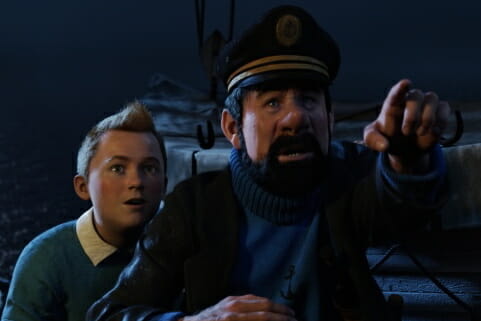
It’s actually somewhat amazing that The Adventures of Tintin marks the first big screen treatment of the immensely popular comic book character in nearly 40 years (and, really, the first one of note originating from Hollywood, ever). After all, the intrepid carrot-topped reporter/sleuth stands with fellow Franco-Belgian characters Asterix and Obelix as a titan of European comics. Created by Belgian artist Georges Remi (under the pen name Hergé), Tintin’s adventures have been translated into more than 50 languages and inspired a decently rabid following of “Tintinologists” who have discussed, debated, critiqued and theorized on virtually every imaginable aspect of Tintin and his friends. (For proof, check out www.tintinologist.org.) Part of that can be attributed to careful guardianship of the property, first by Hergé himself and then by his estate. How else can one explain how a series started in 1929 and involving a resourceful boy and his resourceful and cuddly dog has escaped the clutches of the Disney merchandising behemoth? But then there’s also the fact that the new film’s director, some guy named Steven Spielberg, has held the film rights for nearly 30 years, waiting for the right moment to give Tintin his cinematic due.
The Adventures of Tintin does just that. Not since Rob Reiner’s pop culture quote font, The Princess Bride, or perhaps Peter Jackson’s Lord of the Rings trilogy, has a film worked so hard—and so successfully—to capture the spirit of the source material. (Jackson is a producer of this first film and will direct the sequel.) It’s clever in the best sense of the word—from the Tintin mini-adventure embedded in the opening titles to the meticulous attention to details throughout (a quality for which Hergé himself was so admired). As one would expect from a Spielberg-directed adventure, the pacing is “Raiders brisk”—so much so that there was even a little hesitant expectation at film’s end as half the audience seemed unsure whether the latest climax was the last.
The voice work is superb, so much so that performances aren’t really worth differentiating by quality as by role. Jamie Bell and Andy Serkis inhabit the roles of Tintin and Captain Haddock, respectively, with professional ease (Serkis especially, given the range of bluster and moan called for by Haddock); Daniel Craig is suitably menacing as Sakharine; and Simon Pegg and Nick Frost steal precisely as much of the their scenes as a Tintin fan would hope as Thomson and Thompson, a bumbling pair of detectives without equal (in bumbling, that is).
In addition to the exceptional craftsmanship evident in the more traditional components of movie-making (directing, acting, etc.), The Adventures of Tintin represents an impressive two-fer in technological achievement. First, it’s a good reminder of how potent an immersive experience the latest incarnation of 3D technology can be—especially when it’s the goal from the beginning instead of applied afterword to juice a few dollars more out of box office receipts. Today’s 3D is no longer about errant projectiles and dramatic hand gestures that seem to fly out from the screen; instead, it’s the viewers themselves who are brought into world. Along with the “Dances With Gumby” goodness of James Cameron’s Avatar, Tintin should go down as one of the first of the modern 3D films that does it right.
More importantly, using the motion-capture techniques developed and honed in the creation of Gollum for the Lord of the Rings trilogy, Spielberg and Jackson have finally banished the stubborn lifelessness that has made earlier motion-capture efforts like 2004’s The Polar Express wooden and, occasionally, creepy. The characters are still undeniably CGI, but not distractingly or unnervingly so.
Inevitably, some critics will complain of a lack of emotional heft in Tintin. There’s pretty much zero character arc for the red-tufted one, and there’s certainly little of the growth and cartharsis that make Pixar efforts such as the Toy Story trilogy or The Incredibles so very, very satisfying. Such complaints are actually just further evidence of how well the film captures the essence of the source material. Hergé’s Tintin is at heart a pulp fiction adventurer. As such, he shouldn’t grow—he already possesses his full complement of strengths and weaknesses. This makes Tintin the catalyst for the very adventures he undertakes. And, in a phrase that serves just as aptly to describe The Adventures of Tintin as a whole—that’s just the way it should be.